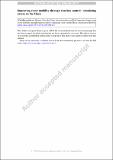Improving rover mobility through traction control: simulating rovers on the Moon
Author(s)
Gonzalez, Ramon; Apostolopoulos, Dimi; Iagnemma, Karl
Download10514_2019_9846_ReferencePDF.pdf (2.339Mb)
Publisher Policy
Publisher Policy
Article is made available in accordance with the publisher's policy and may be subject to US copyright law. Please refer to the publisher's site for terms of use.
Terms of use
Metadata
Show full item recordAbstract
Abstract
This paper shows the performance of various traction control strategies that aim to minimize slippage and wheel fighting by properly adjusting the velocity of each traction wheel in a planetary rover. These strategies are validated through simulations performed in ANVEL (Quantum Signal LLC) and using two rovers currently employed by NASA. These experiments use similar features to those that a planetary rover would face on the Moon such as terrain geomorphology and lunar gravity. After running those experiments, the following conclusions were drawn: (1) when no traction control is considered, results show the rover gets entrapped or makes a shorter progress than when traction control is applied; (2) the proposed traction controllers demonstrate a proper balance between slip-compensation (lowest mean slip) and reduction of wheel fighting effects (less aggressive control actions); (3) after considering two different planetary rovers, it is observed that the mechanical configuration effects slip reduction. These contributions can also be observed in the accompanying videos.
Date issued
2019-03-12Department
Massachusetts Institute of Technology. Department of Mechanical EngineeringPublisher
Springer US